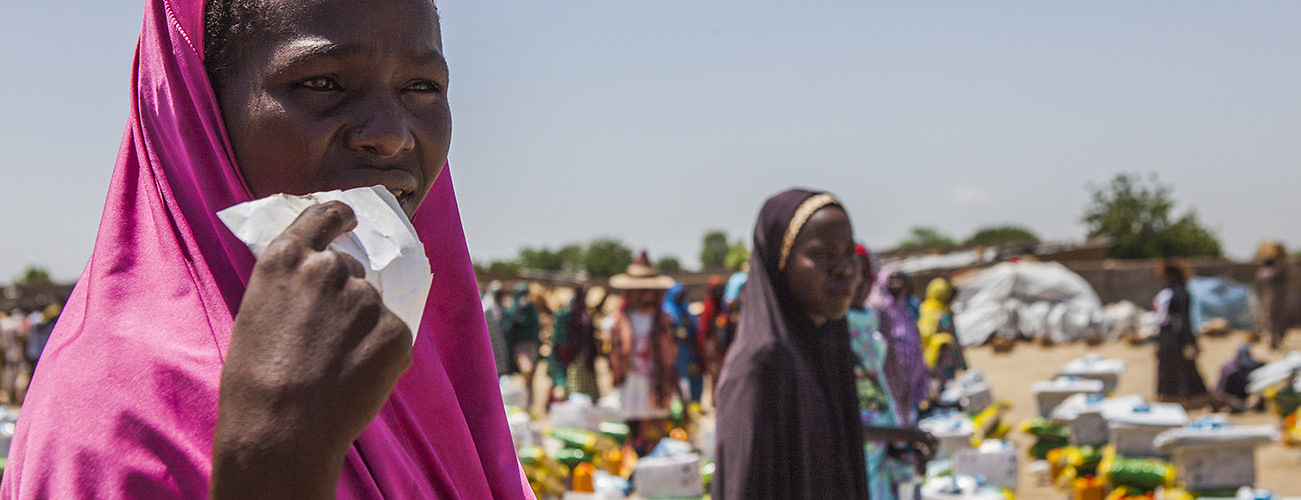Nigerian women wait for food distribution to commence at a camp for displaced people. Monguno, Nigeria, September 27, 2016. (Jane/Washington Post/Associated Press)
On November 6, the All Farmers Association of Nigeria announced that an estimated 400,000 farmers would recommence activities in Borno state, after being displaced at the 2014 height of the Boko Haram insurgency. A marked improvement in regional security will see these farmers return to the local government areas of Kwaya-Kusar, Biu, Hawul, Askira-Uba, Damboa, Chibok, and Bayo.
The significance of this resumption cannot be overstated. In their joint report on “Monitoring food security in countries with conflict situations,” the United Nations Food and Agricultural Organization and World Food Programme noted the mutually reinforcing relationship between conflict and food insecurity. According to their findings, countries experiencing conflict tended to have the highest number of food insecure people. In other instances, food insecurity was either a catalyst for conflict or an obstacle to peace in contexts where conflict was already occurring.
There are few examples of this nexus more conspicuous than northeastern Nigeria, where the Boko Haram insurgency has left an estimated three million Nigerians facing starvation. Indeed, humanitarian agencies have warned that a famine in the northeast is reaching unprecedented levels. Médecins Sans Frontières (MSF) estimates 10 people are dying daily at internally displaced persons (IDP) camps dotted around Borno and the neighboring states of Adamawa and Yobe.
This mortality rate applies only to the estimated two million IDPs reachable by MSF and other aid agencies. The rate among the remaining one million displaced Nigerians remains unclear at this stage, given their location in territories still inaccessible due to the ongoing threat of Boko Haram: One person was wounded on July 27 when a UNICEF convoy was targeted in a rocket attack on a highway linking the town of Bama to the state capital Maiduguri. A week later, an MSF vehicle struck a landmine along the same highway, though no serious injuries were reported.
By its own account, the UN Office for the Coordination of Humanitarian Affairs underestimated the extent of the assistance required in the northeast. Its lack of preparation in this regard is a combination of the difficulties associated with getting verifiable information from the conflict zone—where insurgents and soldiers alike have been hostile to outsiders—and a reluctance by the Nigerian government to seek external assistance. The financially constrained administration of President Muhammadu Buhari has been accused of not allocating enough resources to IDPs, and those resources that have made their way to refugee camps have reportedly been appropriated by corrupt officials.
As well as a major concern on their own, millions of hungry and displaced Nigerians could catalyze a revival in Boko Haram’s armed campaign. With the group’s rank and file decimated by mass killings, arrests and even surrenders, its leadership is focused on replenishing its ranks ahead a possible resurgence in the armed campaign. Indeed, the Nigerian government has also raised concerns that the Islamist sect may already be recruiting desperate refugees within the myriad IDP camps in the northeast. There are also indications that the extremists are becoming resurgent following Buhari’s successful multipronged military campaign, which saw vast swaths of territory controlled by the insurgents—part of an area once said to be the size of Wales—reclaimed.
In recent weeks, the sect has launched a spate of armed attacks in northeastern Borno state targeting military interests. The most significant of these was the September assault on the border town of Malam Fatori, in which as many as 40 Nigerian soldiers were killed, allowing Boko Haram to temporarily regain control. The recent uptick in violence comes amid the conclusion of Nigeria’s rainy season, when once waterlogged roads are rendered passable for the insurgents.
The attacks also come as the government is formally entering negotiations with the sect over the release of the so-called Chibok girls. There are reports that the release of 21 of these girls was achieved in exchange for several Boko Haram detainees that likely include high-ranking militants with skills in bomb-making and strategical and tactical disciplines. More deals of this nature could be likely if pressure on the government to secure the girls is maintained, ultimately leading to further releases of extremists which could significantly reinvigorate Boko Haram’s operational and strategic capabilities.
As shown by the recent announcement on farmers, Boko Haram’s resurgence comes amid a shift in military strategy from reclaiming insurgent-held territories to repopulating and defending these from further rebel attacks. While this seems necessary, the capability of the Nigerian military to achieve it is itself said to still be constrained by inadequate provisions of food, supplies, and ammunition. It is also held back by the prevalence of corruption: There are allegations that military officers have been selling weapons and supplies to Boko Haram members, and that the sect may even be privy to military intelligence such as the movements of commanders spearheading the fight against the Islamist movement. This was recently highlighted by a surprise rebel ambush in Malam Fatori that killed seven soldiers, including Lieutenant Colonel Muhammad Abu Ali, who has played a pivotal role in recent army victories against Boko Haram.
This context only creates an added urgency for addressing the mutually reinforcing relationship between food insecurity and conflict. The fate of the Nigerian government’s attempts to stimulate food production and address mass hunger among the IDP population could play an important role in either starving or feeding Boko Haram’s attempts at resurgence.





